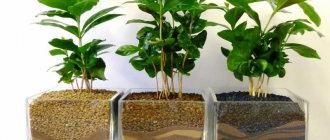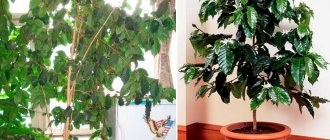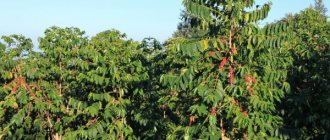The coffee tree is evergreen, decorates the house, smells pleasant during flowering, and also produces fruits - real coffee beans, from which you can make your own drink. Growing coffee at home is not that difficult, but it is interesting. The Arabica variety is most often chosen - it has a bright aroma and rich taste. We tell you all about how to grow a coffee tree at home.
Temperature
Although the coffee tree grows in the tropics, it does not tolerate heat and scorching sun rays. If the plant is too hot, it will not bloom. The tree should be placed in a well-lit place, but so that direct sunlight does not fall on it. If the window in the room faces south, then the flowerpot should be located at a distance of approximately 1.5 m from the glass.
Optimal room temperature for wood:
- in the warm season – from +23 to +25 °C;
- in winter – +17 °C, in extreme cases – not lower than +15 °C.
When caring for a coffee tree, you need to take into account that it does not tolerate changes in orientation in space. Experts do not recommend turning the flowerpot more often than once every 5 years, otherwise the plant will drop its flowers. To make the crown symmetrical, you can place a mirror next to the coffee tree (but so that direct sunlight is not reflected).
Trimming Features
The plant can be pruned at any time of the year, as needed. Remove dry or diseased branches and leaves.
The tree also needs formative pruning, which allows it to be given a certain neat and beautiful shape. Formative pruning is not done in the first year.
Watering
The coffee tree loves moisture, but if the water stagnates in the flowerpot, the roots will begin to rot. Therefore, the plant cannot be flooded, and drainage must be placed at the bottom of the pot. If the tree does not have enough water, the leaves droop and become limp, but after watering they rise very quickly.
The frequency of watering depends on the temperature and humidity. To ensure that the plant does not lack moisture, it is watered with settled water when the substrate in the pot dries at a depth of 1 cm from the surface.
Approximate watering schedule:
- in the warm season - once every 2-3 days;
- in winter - once a week, the water temperature should be 2-3 degrees higher than the air temperature in the room.
From May to September, the coffee tree is sprayed with water from a spray bottle every 1-2 days. To wash off dust from the leaves, wipe them with a damp cloth. The plant can be washed in the shower once a month.
Diseases and pests
The main problems that gardeners face when growing a coffee tree:
- the edges of the leaves darken and dry due to lack of air humidity;
- the leaves of the coffee tree turn yellow when rot appears at the roots;
- brown spots on the leaves appear when there is a lack of nitrogen in the soil;
- holes form in the leaf after sunburn;
- young leaves turn yellow, only green veins remain due to low acidity of the soil;
- leaves turn yellow, rot and fall off after excessive watering;
- In winter, leaves fall off when there is insufficient light;
- grows slowly if there is no regular feeding;
- leaves wrinkle and become covered with yellow spots when watered with hard water or lack of potassium;
- purple or brown spots appear on the leaves when there is a lack of phosphorus in the soil;
- young leaves are small and light yellow due to iron deficiency.
The most common pests found in coffee are scale insects, mealybugs and spider mites.
The soil
The coffee tree likes acidic soil (pH in the range of 5–5.5). Acidity can be measured using litmus paper.
To obtain such a substrate, mix:
- 1 part peat;
- 2 parts river sand;
- 2 parts leaf soil;
- 4 parts manure humus;
- 4 parts of turf land;
- some finely chopped sphagnum moss.
Of the store-bought soil mixtures, the substrate for citrus fruits is ideal for a coffee tree.
Where are the plantations?
Coffee plantations are located in equatorial countries. The trees grow on the African continent, Madagascar, Central and South America, southeast Asia, and Australia.
Coffee trees do not do well in the constant heat of tropical climates. Therefore, they are planted on high mountain slopes with soil of volcanic origin. The optimal height is 1-2.5 thousand m above sea level.
Exposure to the scorching sun is detrimental to plantations. Therefore, in addition to coffee plants, tall trees with a dense crown are planted. Read more in the article “Where Coffee Really Grows.”
Top dressing
The coffee tree blooms and bears fruit intensively, so it needs increased nutrition. It is best to buy a complex fertilizer. The universal organic fertilizer “Miracle of Fertility Sapropel” is well suited for feeding the coffee tree, as well as fertilizers for indoor flowers based on chicken droppings. During the flowering period, the tree can be watered 1-2 times with water infused with straw ash: it is rich in potassium.
Feeding schedule:
- from March to October – once every 2 weeks;
- from November to February – once a month.
If the leaves become dull, wipe them with water and lemon juice (2-3 teaspoons of juice per 1 liter of water). Water the plant with the remainder of the solution (but not more than once a month).
Difficulties with home cultivation
When growing coffee trees, difficulties often arise:
- The culture does not accept proximity to other plants. Therefore, coffee is placed in a room where there are no indoor flowers.
- Falling and yellowing of leaves indicates a violation of irrigation technology . Excessive soil moisture and drying out negatively affects the appearance of the tree.
- The pot of grown coffee must not be rotated or moved to another place. Even a slight turn can cause leaves and buds to fall off.
Growing a coffee tree is quite possible at home. In order for this endeavor to be successful, you just need to adhere to a number of simple rules. By following a number of recommendations, it will be possible not only to grow a healthy plant, but also to collect fruits from it.
Transfer
If the root system has filled the flowerpot, it means it’s time to replant the tree. Plants up to 3 years old are replanted every year. Then the transplant is carried out once every 2–3 years. The pot should be 5–6 cm larger in diameter than the previous one. If an adult plant bears fruit, then it should be replanted immediately after harvesting, before flowering begins (occurs in about a month).
Drainage is placed at the bottom of the flowerpot: expanded clay, clay shards, nut shells or apricot kernels. 1–2 cm of river sand is poured on top, and then a soil mixture prepared in advance.
The coffee tree is replanted together with an earthen lump (transshipment). The root collar should be slightly raised above the soil level in the flowerpot. If the soil subsequently settles due to watering, exposing the upper part of the roots, a layer of rotted manure humus or weathered peat should be poured into the pot.
What's inside a coffee fruit?
Inside each coffee fruit are two beans that are a bit like the size and shape of raw peanuts. You can pick the coffee beans as they ripen to red, or do as they do in Brazil, where the coffee beans are left on the tree until almost all the berries are colored and shriveled, and the berries are easily removed in one go, although some say that this method does not give you the best coffee. Research in Australia shows that fruits harvested at the early stages of red cherries produce better-tasting coffee. These coffee “cherries,” as they are called, are slightly tart but delicious to eat straight from the tree when they are red and ripe. Harvest in eastern Australia usually occurs from November to early December.
Pruning and crown formation
Seedlings of coffee trees are suitable for growing in standard form. Seedlings obtained from cuttings, over time, if you do not form a standard, turn into a dense bush of a spherical shape.
Arabica coffee tree blooming
In the first year, the shoot grows straight upward; there is no need to pinch it. The tree begins to branch in the second year. If you want to form a trunk with a thick crown, you can make a constriction:
- the operation is carried out in late February - early March;
- when the central trunk grows to 25–30 cm, it is tied tightly with reinforced wire at a height of 15–20 cm, 1 cm below the internode;
- pinch the upper bud; if necessary, trim the shoot so that 2 internodes remain above the wire;
- subsequently, all branches above the constriction that grow upward are cut off. The remaining branches are trimmed to your liking to make the tree look aesthetically pleasing;
- after 3–4 years the constriction is loosened, and after a month it is removed. As a result, with a tree height of 50 cm, the crown diameter can reach 1.5 m.
Useful tips
- Try to protect the coffee tree from other indoor plants. This will prevent it from common diseases of domestic flowers.
- When receiving your first harvest, do not try to roast and grind all the grains. Limit the portion to 2–3 brews, and prepare the remaining grains for planting.
- Plant as many coffee seeds as possible. This will allow you to reduce risks in case not all coffee trees sprout, which happens often.
- Arabica does not like frequent changes, so try not to disturb the tree without good reason.
- Do not confuse the lignification process with tree diseases, but this can happen. This is due to the specificity of the process. First, brown spots appear on the green trunk, after which the entire trunk turns brown. After some time, the color changes to lighter.
Watch the video below for the entire growing process:
With proper care, coffee does not experience problems with flowering and fruiting, and given its unpretentiousness and relatively high resistance to disease, in most cases there is no need to take special preventive measures against pests and diseases.
The main thing is to provide access to the sun and water on a schedule, and then you can count on a good harvest of coffee, which will be doubly tastier from the knowledge that the coffee beans were grown with your own hands.
How to start a coffee tree at home
The best option for your home is an Arabica coffee tree. Robusta, although less fastidious, requires cross-pollination, so it is more difficult to get it to bear fruit. If you don’t have enough space in your house, you can buy dwarf Arabica beans or sprouts, one of the most popular varieties is Albert.
There are 3 ways to get a coffee tree:
- sprout from a grain;
- grow a cutting;
- buy in the store.
Growing coffee trees from beans
Ordinary green coffee beans intended for making a drink are unsuitable for germination: they have been collected too long ago and, in addition, they are subjected to special processing.
Coffee beans harvested no more than 1–1.5 months ago have the best germination. Such seeds can be purchased in online stores.
But it is best to ask the owner of the coffee tree for a ripe berry. Nature itself has covered the coffee beans with juicy pulp, so there is no need to soak them.
The optimal temperature for seed germination is from +19 to +24 °C.
Soil composition for sowing:
- 1 part peat;
- 1 part sand;
- 2 parts of turf land.
- The soil mixture must be prepared 2 weeks before sowing.
- Sowing berries:
- the soil in the pot should be moist;
- The berry is placed on its side (flat side down) in a hole approximately 1 cm deep, sprinkled with earth, which is lightly pressed;
- The pot is covered with a jar and placed in a warm, bright place (but it should not be exposed to direct sunlight).
It will take a long time for the berries to germinate, about 3–6 months. But 2 sprouts can appear from the grains at once. They are kept under glass until the cotyledon leaves shed their hard shell. Periodically, condensation is wiped off the walls of the jar. When the cotyledon leaves expand, the plant gradually begins to adapt to the drier climate of the room.
Grains freed from pulp germinate somewhat faster (after 1–3 months).
Sowing the grain:
- The seeds are soaked for 30 minutes in a very weak solution of potassium permanganate, and then for another 30 minutes in aloe juice.
- The grains are planted in the same way as berries: in a hole 1 cm deep, flat side down.
- After planting, the soil is moistened abundantly and the pot is covered with a jar.
Coffee trees grown from beans bloom in the 3rd or 4th year.
Propagation of coffee trees by cuttings
To plant cuttings, prepare a substrate in advance from peat and sand, taken in a 1:1 ratio.
Planting a cutting:
- A branch with 2 pairs of leaves is cut 2.5–3 cm below the bud. The cut should be oblique, it is treated with “Kornevin” or another rooting stimulator.
- The cuttings are vertically stuck into well-moistened soil so that the lower buds are covered with substrate.
- The cutting is covered with a plastic bag in which a small hole is cut. Periodically through this hole the cuttings are sprayed with warm water.
A rooted cutting can be replanted only after a new pair of leaves appears. Coffee trees grown from cuttings bloom in the 2nd or 3rd year.
Buying a coffee tree in a store
Coffee trees sold in stores usually look healthy in appearance: they have dark, shiny leaves and often already have flowers or berries. But it should be remembered that purchased plants are often overfed with fertilizers.
Therefore, you should not be surprised if the tree at home begins to turn yellow and shed its leaves. With normal care it will recover. The main thing is that there are no spider mites. Having brought the tree home, you need to “quarantine” it, separating it from other indoor plants. If spider mites are detected, the coffee tree must be treated with an insecticide. If the plant is healthy, it is replanted.
Conclusions:
- A coffee tree can be easily grown at home: from green seeds by soaking, but easier - from sprouts, which are sold in garden centers or in online stores.
- For coffee, high air humidity, watering with warm water, and morning sunlight are important.
- The soil should be porous, loose, and add pebbles or sand for drainage.
- It is important to replant the plant in time so that a developed root system is formed.
- First use nitrogen fertilizers to stimulate growth, then buy mixtures for citrus or orchids.
How to care
The coffee tree is quite easy to care for. Even a novice gardener can grow a specimen with bright greenery.
Important nuances that experienced flower growers pay attention to:
- Water and spray with filtered warm water.
- The air temperature should be no lower (+22°C), and humidity 70–80%.
- Apply fertilizer twice a month.
- In the autumn-winter period it is necessary to use ultraviolet lamps.
- In the summer, it is advisable to take it out into the fresh air (in the garden, balcony, veranda).
- It is undesirable to rearrange or move the flowerpot with the plant without the need.
- Pruning is done as desired to make the crown thicker.
Location
It is recommended to place the plant on the south side; a room with access to similar directions is also suitable: southwest or southeast. The north window will not provide enough sunlight, you will have to additionally illuminate it with a lamp. In summer it is necessary to shade it from direct sunlight to avoid burns on the leaves.
Temperature
For good growth and fruiting, the plant needs: temperature +22…+25°C. In winter, the air should not cool down to +12...+13°C, this has a detrimental effect on the flower. If necessary, the ornamental plant is transferred to a heated room.
Lighting
The plant is light-loving. If there is insufficient lighting, the exotic tree does not bloom, grow, or bear fruit well.
It is advisable to place the coffee tree in rooms where there is a lot of light: south or southeast. In summer, shade from exposure to direct sunlight.
If the windows face north, additional lighting is necessary, otherwise the flower may wither due to lack of light. LED lamps or fluorescent lamps are used as artificial lighting.
Watering and humidity
Important points:
- The coffee tree prefers high humidity, as well as air temperature (+25°C).
- Water and spray with settled warm water; in the spring-summer period, they are guided by the dryness of the earthen clod.
- In winter, the substrate is moistened at intervals of three to four days, but the greens must be irrigated every day.
- Water stagnation is not allowed to prevent the root system from rotting.
Fertilizers and fertilizers
For abundant flowering and fruiting, fertilize with liquid fertilizers (mineral or organic).
In summer, nutrition must be increased: active growth occurs, flowers appear, fruits ripen.
The following are used as mineral fertilizers:
- nitrogen (ammonium sulfate, urea, sodium nitrate) – promotes the growth of stems and foliage;
- potassium (potassium magnesium or potassium salt) – increases resistance to disease and increases the quality of buds and coffee beans;
- phosphorus (ammophos, superphosphate, diammophos) – strengthens roots, improves flowering and fruiting.
Nitrogen fertilizers are used only in the spring, and phosphorus-potassium fertilizers are used in the summer and autumn months. In winter, it is not recommended to feed the plant.
Organic fertilizers include:
- rotted compost (contains potassium, phosphorus and nitrogen);
- peat (replaces nitrogen);
- ash (analogue of potassium).
Nutrients are applied to moist soil in liquid form once every 14 days. The best option is to use natural products and organic matter.
Pruning and crown formation
The plant forms a crown on its own; pruning is needed only when the tree has grown too tall. You can pinch the top branches, this will allow the side stems to grow.
Transfer
The tree is replanted after the seeds have sprouted and the cuttings have formed roots, when the plant has little space in the pot (the roots are visible from the drainage holes).
Basic Rules:
- prepare the soil;
- select the pot size;
- place drainage at the bottom of the container;
- carefully remove the plant from the old pot;
- inspect the root system;
- transferred to a new flowerpot, planted;
- water with warm, soft water;
- It is enough to replant an adult plant once every 3 years, and a young one every year.
Visual video - instructions for transplanting a coffee tree:
Reproduction
Process Features:
- There are two proven methods: propagation of an exotic tree using grains and cuttings.
- Take green seeds.
- If propagated by shoots, then it is necessary to cut off the stem with 4–6 leaves.
- Stimulate them with phytohormones, and additionally scarify the seeds.
- Plant the grain with its flat side in moist soil and deepen it 1 cm into the soil.
- The cuttings are planted to a depth of 2 cm, greenhouse conditions are created: temperature - about +25 degrees, humidity - 70%.
- A month later, a sprout appears, and the shoot has new leaves and a formed root.
- The grown bush is transplanted into a new flowerpot.
Characteristic
Coffee tree (Coffea) is a tall bush or tree from the Rubiaceae family. Plants from this family have the main distinctive feature - the alkaloid caffeine is present in their stems, leaves and fruits. Some species contain more of it, others in minute quantities.
The Coffee genus is one of the leaders in caffeine content. In addition, this tonic substance is present in all parts of the plant. Botanists count about 90 species that can be called coffee trees. Some of them grow as tall bushes. But most often coffee is evergreen spreading trees.
Ethiopia is considered the birthplace of the famous plant and the drink made from it. It was here that they first began to prepare an aromatic, tonic drink from fried fruits.
Coffee trees are found in the wild in Asia and Africa. The largest industrial coffee plantations today are in India, Sri Lanka and Brazil. The heat-loving plant does not grow in our latitudes, but is quite suitable for greenhouse or home cultivation.
Coffee, the cultivation of which at home provides the tree with a compact size, has a height in adulthood that does not exceed 1.5 m. Coffee branches grow in regular tiers and are most often directed horizontally. This makes it easy to form a trunk and keep the crown to a given size.
The leaves of the plant are dark green and very showy. Leathery, shiny plates grow opposite and thickly cover the vertical stems. The shape of coffee leaves can be oval or lanceolate, the tip is always pointed, and the edges have a slight waviness.
Flowering of coffee begins only from the 3rd year of life. Flower buds are formed in the axils of leaves during 1-year growth. The flowers are snow-white or cream, have 5 petals and are collected in umbrella inflorescences.
Coffee buds remain closed on the branches for about 30 days, and only then the flowers bloom completely. After the petals open, they exude a delicate, strong aroma. A bisexual crop does not require cross-pollination. The ovaries form independently inside the flower.
The fruits that appear after flowering look like yellowish, and later bright red berries. The diameter of the coffee “berry” does not exceed 1.5 cm. The fruits in appearance are very similar to ripe cherries with a slightly elongated shape. During fruiting, the stems of the coffee tree are densely covered with groups of bright berries. Under the dense skin of each of them there is juicy, sour pulp. Inside, 2 grains ripen, closely pressed to each other.
It takes at least 4 (sometimes up to 6) months for coffee to fully mature. Ripened grains do not have a pronounced smell or taste, and their color remains light cream. Coffee acquires its characteristic color and specific aroma only after roasting.
An adult tree from a plantation produces up to 3 kg of ripe grains per year. From a houseplant in the same period you can collect up to 500 g of full-fledged coffee fruits. Homemade crops should be withered, peeled and dried. The grains are then roasted and used to brew an aromatic drink according to conventional recipes.
Not all types of coffee are suitable for home cultivation. Typically the variety is selected from the Arabian or Liberian varieties. Especially popular in potted coffee is Nana, a dwarf tree, Arabica variety.
The most suitable types of coffee trees for growing at home:
| View | Tradename | Peculiarities |
| Arabian | Arabica | In the natural environment it exceeds 5 m. At home it grows to a maximum of 100 cm. |
| Congolese | Robusta | It grows quickly and does not require special care, but is distinguished by its ability to shed fruit-bearing shoots along with the leaves. |
| Liberian | Liberica | Even at home, it develops a powerful root system and has impressive growth. Suitable for cultivation in greenhouses or large winter gardens. |
Due to the characteristics of coffee development, gardeners most often choose the compact Nana variety for home cultivation. Its large, glossy leaves reach 40 cm in length, while the height of the stem rarely exceeds 80 cm. Nana coffee bears fruit well in an ordinary apartment and is decorative all year round.
Growing from cuttings
There are 2 methods of obtaining new shrubs: from seeds and cuttings. The best way to grow a coffee tree is by planting cuttings. With this method, the plant will grow faster, flowering begins earlier, and after 12–24 months the first fruit grains appear. For seeds, this period will last 36–48 months.
The cutting takes root more easily, after rooting it will grow well in width, and it is easier to form a crown on such a seedling. Planting is not labor intensive and does not require special skills. After a few years, shoots can be cut from the ornamental plant for sale or propagation.
How to choose a seedling
Basic rules for choosing cuttings:
- carefully inspect the plant for damage;
- the leaves should be bright green, there should be no spots, holes or dents;
- there must be foliage on the trunk;
- check for insect pests and diseases.
The Nana variety is suitable for growing as an ornamental plant; it does not produce fruit, but is distinguished by bright and rich buds. The Arabica variety is chosen to obtain coffee beans: its spectacular appearance will also be a beautiful decoration for the home.
When purchasing a seedling in a store in winter, the plant must be insulated to prevent freezing outside. To protect the young specimen, use paper or a plastic bag.
How to plant
In order for the coffee tree to take root and be able to harvest in the future, planting should be done correctly:
- It is better to use a ready-made substrate for citrus plants as soil.
- Take a small pot: for the first planting (12 by 8 cm).
- Drainage (pebbles, pebbles, crushed stone, broken brick) is poured into the bottom of the flowerpot.
- The lower part of the cutting must be kept in a growth stimulator for 12 hours.
- The shoot is placed in moist soil.
- Cover it (with a large jar, cellophane) and create greenhouse conditions.
- Place in a warm (+22…+25°C) and illuminated area.
- Periodically open it slightly for ventilation and remove condensation from the lid.
- If necessary, water and spray with settled water.
- After 3–4 weeks, new leaves will begin to grow, and the plant is freed from greenhouse conditions.











